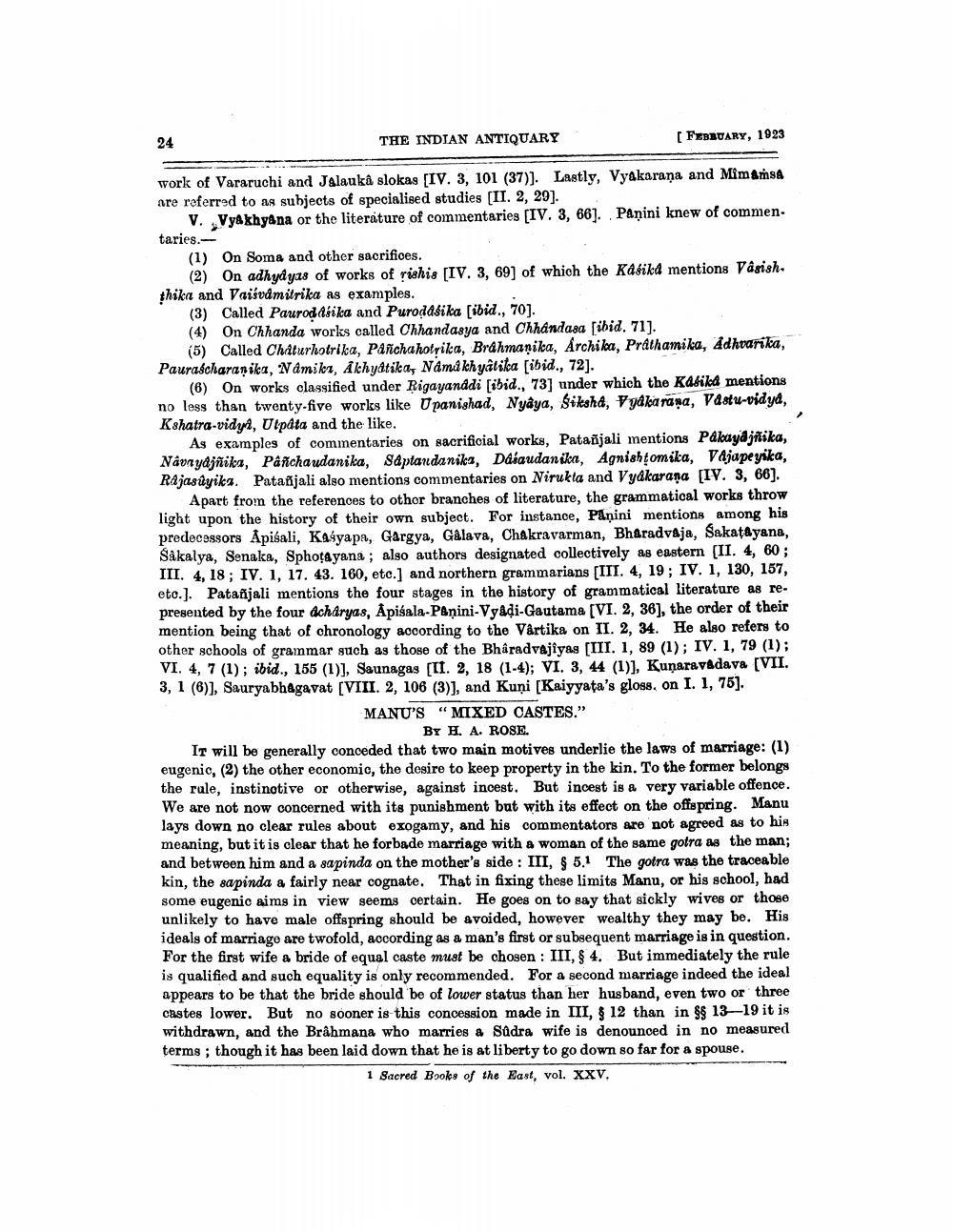________________
24
THE INDIAN ANTIQUARY
work of Vararuchi and Jalaukâ slokas [IV. 3, 101 (37)]. Lastly, Vyakarana and Mimamsa are referred to as subjects of specialised studies [II. 2, 29].
V.Vyakhyana or the literature of commentaries [IV. 3, 66]. Panini knew of commen
[ FEBRUARY, 1923
taries.
(1) On Soma and other sacrifices.
(2) On adhyayas of works of rishis [IV. 3, 69] of which the Kasika mentions Vâsish. thika and Vaisvamitrika as examples.
(3) Called Paurodasika and Purodášika [ibid., 70].
(4) On Chhanda works called Chhandasya and Chhandasa [ibid. 71].
(5) Called Chaturhotrika, Pañchahotrika, Brahmanika, Archika, Prathamika, Adhvarika, Pauraścharanika, Namika, Akhyatika, Namakhyâtika [ibid., 72].
(6) On works classified under Rigayanddi [ibid., 73] under which the Kábika mentions no less than twenty-five works like Upanishad, Nyaya, Siksha, Vyakarana, Vastu-vidya, Kshatra-vidy, Utpâta and the like.
As examples of commentaries on sacrificial works, Patanjali mentions Pakayajnika, Navayajnika, Pâñchaudanika, Saptandanika, Dáiaudanika, Agnishtomika, Vajapeyika, Rajasayika. Patanjali also mentions commentaries on Nirukta and Vyakarana [IV. 3, 66].
Apart from the references to other branches of literature, the grammatical works throw light upon the history of their own subject. For instance, Panini mentions among his predecessors Apisali, Kasyapa, Gargya, Galava, Chakravarman, Bharadvaja, Sakatayana, Sakalya, Senaka, Sphotayana; also authors designated collectively as eastern [II. 4, 60; III. 4, 18; IV. 1, 17. 43. 160, etc.] and northern grammarians [III. 4, 19; IV. 1, 130, 157, etc.]. Patanjali mentions the four stages in the history of grammatical literature as represented by the four acharyas, Apisala-Panini-Vyadi-Gautama [VI. 2, 36], the order of their mention being that of chronology according to the Vârtika on II. 2, 34. He also refers to other schools of grammar such as those of the Bharadvajîyas [III. 1, 89 (1); IV. 1, 79 (1); VI. 4, 7 (1); ibid., 155 (1)], Saunagas [II. 2, 18 (1-4); VI. 3, 44 (1)], Kunaravadava [VII. 3, 1 (6)], Sauryabhagavat [VIII. 2, 106 (3)], and Kuni [Kaiyyata's gloss. on I. 1, 75].
MANU'S "MIXED CASTES."
BY H. A. ROSE.
Ir will be generally conceded that two main motives underlie the laws of marriage: (1) eugenic, (2) the other economic, the desire to keep property in the kin. To the former belongs the rule, instinctive or otherwise, against incest. But incest is a very variable offence. We are not now concerned with its punishment but with its effect on the offspring. Manu lays down no clear rules about exogamy, and his commentators are not agreed as to his meaning, but it is clear that he forbade marriage with a woman of the same gotra as the man; and between him and a sapinda on the mother's side: III, § 5.1 The gotra was the traceable kin, the sapinda a fairly near cognate. That in fixing these limits Manu, or his school, had some eugenic aims in view seems certain. He goes on to say that sickly wives or those unlikely to have male offspring should be avoided, however wealthy they may be. His ideals of marriage are twofold, according as a man's first or subsequent marriage is in question. For the first wife & bride of equal caste must be chosen: III, § 4. But immediately the rule is qualified and such equality is only recommended. For a second marriage indeed the ideal appears to be that the bride should be of lower status than her husband, even two or three castes lower. But no sooner is this concession made in III, § 12 than in §§ 13-19 it is withdrawn, and the Brahmana who marries a Sûdra wife is denounced in no measured terms; though it has been laid down that he is at liberty to go down so far for a spouse.
1 Sacred Books of the East, vol. XXV.




